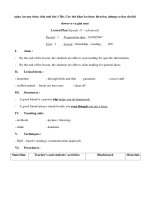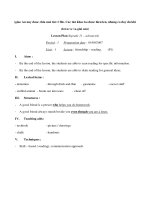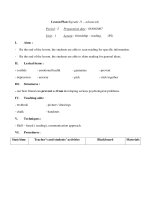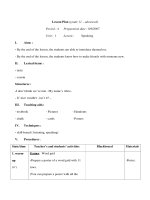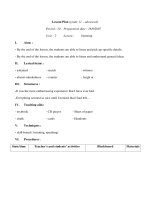Giáo án Anh văn lớp 11 - Unit 1- Period 1 pptx
Bạn đang xem bản rút gọn của tài liệu. Xem và tải ngay bản đầy đủ của tài liệu tại đây (162.07 KB, 44 trang )
(giao An nay duoc chia moi tiet 1 file. Cac tiet khac ko duoc hien len, nhung co day du khi
down ve va giai nen)
Lesson Plan 1(grade 11 – advanced)
Period : 1 Preparation date : 03/09/2007
Unit : 1 Lesson : friendship – reading. (P1)
I. Aims :
- By the end of the lesson, the students are able to scan reading for specific information.
- By the end of the lesson, the students are able to skim reading for general ideas.
II. Lexical items :
- detention - through thick and thin - guarantee - soccer stuff
- stuffed animal - break out into tears - cheat off
III. Structures :
- A good friend is a person who helps you do homework.
- A good friend always stands beside you even though you are a loser.
IV. Teaching aids:
- textbook - picture / drawings
- chalk - handouts
V. Techniques :
- Skill – based ( reading), communication approach.
VI. Procedures :
State/time Teacher’s and students’ activities Blackboard Materials
1. Warm-
up & lead-
in
(3’)
Games: Treasure Hunt.
- Divide the class into two groups
- Stick 6 pictures of things (or draw the
things) on the board.
- Tell Sts to find out the treasure, the word
of the day by combining the first letter in
the names of these things .
- The first group to find it will win the
game
- Sts start the game.
( These pictures are about Flower, Ring,
Ice-cream, Eye, Nurse, Dog. The word of
the day is FRIEND)
- Declare the winner.
- Ask Sts : do you have friends?
What is a good friend like,
according to you?
- Teacher leads in the new lesson: “ in
today’s reading, we’ll get to know more
about friends and friendship.
- T writes down on the board
Stick pictures on the board
The word of today :
FRIEND
:Period 1 : Unit 1 :
Friendship.
Pictures
or
drawing
Chalk and
board.
2. Pre-
reading
(5’)
Teaching Vocabulary
- write new words on the bb.
- elicit meanings from Sts or give
explanations yourself
- leave some minutes for Sts to copy.
- give some practice on pronunciation ( T
reads – Sts repeat in chorally, then asks
Sts to read individually.)
- Remind Sts of Relative Clause, how to
use.
- stick together (v): gắn bó
- through thick and thin
(idm): trong bất kỳ hoàn
cảnh nào
- cheat (v) : gian lận trong
ktra
- break out into tears (v) =
begin to cry
- detention (n): hình phạt
sau giờ học
A goof friend was the
person who helped you pack
up ……
Chalk and
board
3. while -
reading
(15’)
Activity 1: reading and matching (task
a, p16)
- Ask Sts to read Text A and then match
the grades with John’s opinions on what a
good friend is.
- Call on Sts to say what John thought of a
good friend in each grade.
- go over the answers with the class.
Activity 2: Main ideas
Answers :
1. c
2. b
3. a
Chalk +
book +
small
board
- T writes down on the board three
phrases about the main ideas of the
paragraphs B and one extra phrase.
- Ask Sts to skim the text again and match
the paragraphs with their suitable main
ideas.
- When they have finished , tell Sts to
compare answers with a partner.
- Go over the answers with the class.
a. Possible reasons for not
having a best friend.
b. How best friendship
develops
c. John’s opinions on
“friendship” during his
school years.
4. Post-
reading
(15’)
Activity 1: checking vocabulary : gap-
filling
- Give Sts handouts and ask them to work
in pairs, completing the sentences, using
the words just learned.
- check with the class
Activity 2 : writing: sentence building.
- Give Sts handouts , and ask them to
1. A good friend remains
loyal to you ……
2. Being scolded by his
mother, the child ……….
3. Those students were sent
to the ……. Room for their
cheating on the exam.
Answers : 1. through thick
and thin; 2. broke out into
tears ; 3. detention.
1. your ideas/ good friend/
-
Handouts
Handouts
make sentences using the cues.
- Sts do the task
- T correct them.
different/ different grades.
2. best friends / usually /
stick together/ thick/ thin.
3. best friend/ help you/
avoid/ depression/ anxiety.
5. Other
activities
(5’)
- Ask one or two Sts to sing a song telling
about friendship
- Sts do the task
6.
Homework
(2’)
- Ask Sts to learn new words by heart and
review the today’s lesson.
- Prepare the new lessons for the next time
Book and
notebook
Lesson Plan 1(grade 11 – advanced)
Period : 2 Preparation date : 05/09/2007
Unit : 1 Lesson : friendship – reading. (P2)
VII. Aims :
- By the end of the lesson, the students are able to scan reading for specific information.
- By the end of the lesson, the students are able to skim reading for general ideas.
VIII. Lexical items :
- confide - emotional health - guarantee - prevent
- depression - anxiety - pick - stick together
IX. Structures :
- our best friend can prevent us from developing serious psychological problems.
X. Teaching aids:
- textbook - picture / drawings
- chalk - handouts
XI. Techniques :
- Skill – based ( reading), communication approach.
XII. Procedures :
State/time Teacher’s and students’ activities Blackboard Materials
1. Warm-
up & lead-
in
(4’)
Checking the previous lesson:
- T reads John’s opinions on a Good
friend:
a. pack up toys and old stuff; empathize
with you in bad times
b. let you copy his / her paper in an exam.
c. be on you side through good and bad
times.
- Sts say the grade (eighth, ninth, or tenth)
for each opinion.
- T gives feedbacks.
- Eighth grade
- Tenth grade
- Ninth grade
Transition : what do you think about
above ideas? To know what is a best
friend, today we’ll continue learning
paragraph 2.
- T write the lesson on the bb:
Period 1 : Unit 1 :
Friendship – reading (p2)
Chalk and
board.
2. Pre-
reading
(5’)
Teaching Vocabulary
- write new words on the bb.
- elicit meanings from Sts or give
explanations yourself
- leave some minutes for Sts to copy.
- give some practice on pronunciation ( T
reads – Sts repeat in chorally, then asks
Sts to read individually.)
- Remind Sts of how to use the verb :
prevent S.O / S.T from V-ing
- to confide:
- emotional (adj.)
- guarantee (n) :sự đảm bảo
- depression (n)
- anxiety (n) = worry
Anxious(adj.) = worried
- to pick = to collect
- to stick together : gắn bó
- to evolve = to develop
Our best friend can prevent
us from developing serious
psychological problems.
Chalk and
small
board
3. while -
reading
(15’)
Activity 1: True – False statements(task
b, p16)
- Ask Sts to read the statement about close
friends in Task b (p16)and say if they are
true or false , i.e, Sts agree or disagree
with them
- Check with the class and note down on
the board Sts’ opinions.
- Tell Sts to read Text B and decide if the
statements are true or false.
- go over the answers with the class.
Activity 2: Main ideas
- T writes down on the board three
phrases about the main ideas of the
paragraphs B and one extra phrase.
- Ask Sts to skim the text again and match
the paragraphs with their suitable main
ideas.
- When they have finished , tell Sts to
compare answers with a partner.
- Go over the answers with the class.
Answers :
1. c
2. b
3. a
a. Possible reasons for not
having a best friend.
b. How best friendship
develops
c. John’s opinions on
“friendship” during his
school years.
Chalk +
book +
small
board
4. Post-
reading
(15’)
Activity 1: checking vocabulary : gap-
filling
- Give Sts handouts and ask them to work
in pairs, completing the sentences, using
the words just learned.
- check with the class
Activity 2 : writing: sentence building.
- Give Sts handouts , and ask them to
make sentences using the cues.
- Sts do the task
- T correct them.
1. Blue skies are not a …….
of continuing fine weather.
2. Like friendship, trust …
with time.
3. Ann thinks there’s no one
in the class she can ……
Answers : 1. guarantee ;2.
evolve ; 3. confide in
1. best friends / someone /
you can confide
2. your ideas/ good friend/
different/ different grades.
3. best friend/ help you/
avoid/ depression/ anxiety.
-
Handouts
Handouts
5. Other
activities
(5’)
- Ask one or two Sts to sing a song telling
about friendship
- Sts do the task
6.
Homework
- Ask Sts to learn new words by heart and
review the today’s lesson.
Book and
(1’)
- Prepare the new lessons for the next time
notebook
Lesson Plan (grade 11 – advanced)
Period : 3 Preparation date : 6/9/2007
Unit : 1 Lesson : listening
XIII. Aims :
- By the end of the lesson, the students are able to listen and pick up specific details.
- By the end of the lesson, the students are able to listen and understand general ideas.
XIV. Lexical items :
- social - sensitive - indifferent
- conservative - skinny - stout
XV. Structures :
- she looks athletic with her hair cut short and casual clothes.
- it was her rosy plump face …. That attracted me at the first look.
XVI. Teaching aids:
- textbook - CD player - Sheet of paper
- chalk - cards -
XVII. Techniques :
- skill-based ( listening, speaking)
XVIII. Procedures :
State/time Teacher’s and students’ activities Blackboard Materials
1. warm-
up
(4’)
Games: “ Five little things”
- Ask Sts to work in group of 4
- Tell Sts to listen to instructions and write
down 5 things as required on a piece of
paper
- The group that finishes first and gets all
correct will get one point
- The group that has more points will win
the game.
- Check Sts’ understanding of instructions
and have them start the game.
Transition: we use a lot of nouns and
adjectives to talk about friends. Today we
will listen to a letter from Jack, writing
about his new friend.
- write down on the board :
These are the suggested
instructions:
1. write down 5 places
where you often meet with
your close friend.
2. write down 5 things you
often share with your close
friend.
3. write down 5 qualities
you need in a good friend.
Unit 1 : Friendship-
Listening
- sheets of
paper.
2. Pre-
listening
(5’)
Teaching new words:
- use pictures and explanations to present
some new words
- Read the words one by one and ask Sts
to repeat.
+ sociable (a.) : friendly,
+ conservative (a) :bao thu
+ sensitive (a) : nhay cam
+ skinny (a) : very very thin
+ stout (a) : rather fat
Chalk and
board
Describing yourself (Task a, p17)
- Ask Sts to read the list of adjectives and
tick the words that describe them and add
more adjectives that are true for them
- Call on one student or two read their list
that describes themselves
+ indifferent (a) : having no
test
Task a:
Students’ answers.
Textbook
3. while-
listening.
(15’)
Activity 1: Listen and tick (Task b, p17)
- Tell Sts they are going to listen to a
letter from Jack, writing about his new
Vietnamese friend, Mai.
- Ask Sts to listen and tick what is true
bout her.
- Let Sts listen for the second time if
necessary
- Go over the answers with the class.
Activity 2: Listen and take notes
- Ask Sts to listen again and note down
the noun phrases used to describe Mai’s
appearance
Task b:
1. sociable
2. enthusiastic
3. practical
4. athletic
5. attractive
6. sensitive
Listen and take notes
Expected answers: - her rosy
plump face , - two dimples (
on her cheeks), - short hair, -
Textbook
and CD
player
CD
player
and chalk
- call on Sts to read their notes and check
with the class.
casual clothes
+ bb
4. Post-
listening
(15’)
Speaking : Role play ( Handouts)
- pair of Sts as A and B and tell A to play
the role of Jack an B the role of Sinh. Sts
imagine they are having a conversation on
the phone
- give each student a role card and ask
them to make a conversation based on the
ideas suggested.
- Move around to control and give help if
necessary.
- If time allows, have 1 or 2 pairs to act
out their conversations in front of the
class.
- Ask for Sts’ comments and then give
feedback.
Card 1- Jack and card 2 –
Sinh are delivered out Sts.
Handouts
5.
Homework
(1’)
Vocabulary review
- tell Sts to learn the new words and make
some sentences with them, describing a
certain person.
.
textbook
Lesson Plan (grade 11 – advanced)
Period : 4 Preparation date : 8/9/2007
Unit : 1 Lesson : Speaking
XIX. Aims :
- By the end of the lesson, the students are able to introduce themselves.
- By the end of the lesson, the students know how to make friends with someone new.
XX. Lexical items :
- tasty
- cousin
Structures :
-I don’t think we’ve met . My name’s Alice
- It’ nice weather , isn’t it?
XXI. Teaching aids:
- textbook - Pictures - Handouts
- chalk - cards -Posters
XXII. Techniques :
- skill-based ( listening, speaking)
XXIII. Procedures :
State/time
Teacher’s and students’ activities Blackboard Materials
1. warm-
up
(4’)
Games: Word grid
-Prepare a poster of a word grid with 11
rows.
(You can prepare a poster with all the
word in their rows and cover each rows
with a piece of paper. When SS get it right
,you just need to uncover that row)
( Appendix1 )
- Ask Sts to work in group .
- Tell SS to take turns to choose a
numbered row
-Poster.
-Read the explanation for the word in that
row , and the group try to say what the
word is. If the group get it right, they
score 1 point. If they get it wrong, the
other group have the chance to say the
word and score the point.
-After 6 rows have been revealed , the
groups are allowed to guess the word in
the column. If they get it right , they win 5
points.
- The group that has more points will win
the game.
- Check Sts’ understanding of instructions
and have them start the game.
-Keep a running total of points for each
group on the boar
-Declare the winner.
Transition How do you make friends with
people? Today we will focus on making
friend at parties and in public places.
-Write down on the board :
Unit 1 : Speaking –
Making Friends
2. Pre-
Speaking
(5’)
Eliciting and Introducing Useful
Language
-Ask SS : What do you do /say to make
friends with someone new?
-Note SS’ ideas on the board.
-Tell Ss to read the expressions in task a (
p.18) and tick the ones that they can you
to start a conversation.
-give comments and then introduce to Ss
some ways to start a conversation with
someone.
Expected answer:
2,3,4,5,6,7,and 8
1.Introducing yourself
+Hello, my name’s …./Hi,
I’m….I’m from….
+Hello, my name’s …., by
the way.
2.Checking if you know
someone
+I don’t think we’ve met.
My name’s….
+Haven’t I seen you at…?
3. Making offers
+Would you like something
to drink/ to eat ?
Chalk and
board
Chalk and
board
-Tell SS they can use the expression in 3
and 4 either to start a conversation and
make friends with someone new or to
maintain a conversation.
-Read the expressions one by and ask SS
to repeat.
+How about trying ….?
4. Commenting on the
situation
+It’s a great party, isn’t it?
+The music sounds great,
doesn’t it?
3. while-
Speaking.
(15’)
Activity 1:Completing and Practising
the Dialogues (Task b, p.18-19)
- Tell Sts to complete the dialogues in task
(p.18-19).
-Check with the class by calling 2 pairs to
act out the conversations.
-Tell SS to work in pairs and act out the
conversations.
-Call on some close and open pairs to act
out.
Activity 2: Role- play
- Prepare sets of 4 personal information
cards . ( Appendix2 )
- Ask SS to work in groups of 4.
-Give each group a sets of 4 card and tell
Expected answer:
1.I’m… 2.Try /
Have….
3.It’s good / It tastes good
4.Iss’t it/ doesn’t it…
5. would you like…/ could I
get you ….
6.It’ s…. 7.Isn’s it
8. Have I met
9. at….
Textbook
Personal
experience
SS they are now the person described on
the card and they are at a multi- school
party.
-Go around to control and give help if
necessary.
-Call on someone SS to the front of the
class to act out the conversations.
-Give feedback and comments.
cards
Lesson Plan (grade 11 – advanced)
Period : 5 Preparation date : 10/9/2007
Unit : 1 Lesson : writing
XXIV. Aims :
- By the end of the lesson, the students are able to describe a friend.
- By the end of the lesson, the students are able to write a narrative.
XXV. Lexical items :
- vicious - imbecile - confess
- smart - criticize - giggle
XXVI. Structures :
- He had a way of criticizing you that made people laugh at you.
- He was the same age with us but very tall with black hair cut very short.
XXVII. Teaching aids:
- textbook - handouts - Sheets of paper
- chalk and board
XXVIII. Techniques :
- writing-based ( communicative approach.)
XXIX. Procedures :
State/time Teacher’s and students’ activities Blackboard Materials
1. warm-
up
(7’)
Games: memory check
- Hang a poster with descriptive adjectives
on the board
- Tell Sts to look at the words for a few
seconds, and try to remember them.
- Put the poster away and ask Sts to write
down as many words they can remember
as possible. The St with the most words
listed wins the game.
- Ask the Sts how she/he can remember so
many words.
- Tell Sts if they put things under some
classifications, it’s easier to remember
them
Transition: we use these kinds of adjective
to describe people. You will need to use
them in writing a narrative about a friend
of yours, which is the focus of today’s
lesson.
- write down on the board :
These are adjectives :
Tall beautiful kind
smart timid
handsome
Short pretty thin
Black curly long
Shy straight slim
Unit 1 : Friendship-writing
- s
2. Pre-
writing
(10’)
Teaching new words:
- use pictures and explanations to present
some new words
- Read the words one by one and ask Sts
to repeat.
Checking Vocabulary
- Rub out one or some the words and ask
Sts to read them all again.
- Continue until no word is left on the
board
Activity 1: Gap-filling (Task a, p20)
- Ask Sts to read the passage and fill in
each gap with suitable word from the box.
- When they have finished, tell Sts to
word with a partner and compare answers.
- Call on some Sts to read their completed
sentences and check with the class.
Activity 2: Re-ordering (Task b, p 20-
21)
- Ask Sts to work in pair, reading the
sentences and putting them in the logical
- vicious (a) xau xa
- imbecile ( n) : fool
- smart (a) : clever,
intelligent
- criticize (v) ; chi trich, phe
binh
- confess (n) : admit
- giggle (n) : cuoi ruc rich
.
Expected answers:
1. Tall 2. slim 3.
short
4. appearance 5. controlled
6. smart 7. vicious 8.shy
9. timid 10. imbecile
11. imbecile 12. imbecile
13. terrified.
Expected answers:
Chalk and
board
textbook
order of a narrative.
- Call on Sts to read the sentences in the
order they arrange and check with the
class.
4 – 10 – 8 – 3 – 2 – 6 – 1 – 7
– 9 – 5.
3. while-
writing
(20’)
Writing a narrative ( Task c , p21)
- Ask Sts to write a short narrative about a
friend of theirs based on the ideas
suggested and the samples in Task a and
b.
- Go around to control and give help if
necessary
- When they have finish, collect Sts’
writings.
Textbook
4. Post-
writing
(10’)
Peer correction
- Ask Sts to work in group of 5, deliver
each group 5 pieces of writings and tell
them to read and correct their friends’
narratives.
- Tell each group to choose the best piece
of writing, and the most special story.
- Go around to control and give help if
Card 1- Jack and card 2 –
Sinh are delivered out Sts.
Handouts
+ sheets
of paper
necessary.
- Call a St. from each group to read their
group’s best writing, and ask Sts to give
comments.
- If time allows, ask the groups to talk
about their special story.
- Give feedback and comments
5.
Homework
(1’)
Recognizing
Ask Sts to underline all the adjectives
used to describe Trang in Task b.
.
textbook
Lesson Plan (grade 11 – advanced)
Period : 6 Preparation date : 11/9/2007
Unit : 1 Lesson : writing (cont)
XXX. Aims :
- By the end of the lesson, the students are able to describe a friend.
- By the end of the lesson, the students are able to write a narrative.
XXXI. Lexical items :
- timid - crazy - slim
- controlled - terrified - appearance
XXXII. Structures :
- He had a way of criticizing you that made people laugh at you.
- He was the same age with us but very tall with black hair cut very short.
XXXIII. Teaching aids:
- textbook - handouts - Sheets of paper
- chalk and board
XXXIV. Techniques :
- writing-based ( communication approach)
XXXV. Procedures :
State/time Teacher’s and students’ activities Blackboard Materials
1. warm-
up
(7’)
Checking Vocabulary
- T ask two Sts to write adjectives used to
describe appearance.
- After Sts finish , T gives feedback and
leads in the new lesson :
Today we’ll continue using adjectives
describing appearance to make writing a
letter of embarrassing experience
Expected answers:
Tall beautiful kind
smart timid
handsome
Short pretty thin
Black curly long
Shy straight slim
- s
- T writes on the board
Unit 1 : Friendship-writing
(cont)
2. Pre-
writing
(10’)
Teaching new words:
- use pictures and explanations to present
some new words
- Read the words one by one and ask Sts
to repeat.
Gap-filling:
- T asks Sts to read the passage and fill
quickly again in each gap with a suitable
word answers
Questions and answers
- T makes questions about the narrative in
Task b, and ask Sts to find answers to the
New words
- timid (a) : shy
- crazy ( a) : điên rồ
- controlled (a) : kìm chế
- terrified (a) : fearsome
- slim (a) thon thả, mảnh
mai
Expected answers:
1. Tall 2. slim 3.
short
4. appearance 5. controlled
6. smart 7. vicious 8.shy
9. timid 10. imbecile
11. imbecile 12. imbecile
13. terrified
The questions:
Chalk and
board
textbook
